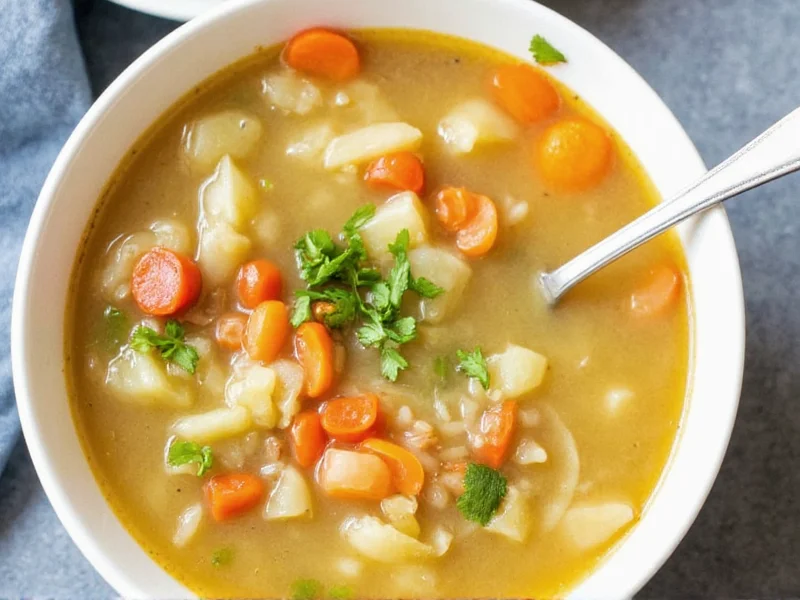Cabbage soup represents one of the most versatile and nutritionally dense comfort foods across global cuisines. This humble dish provides exceptional value through its simplicity, affordability, and remarkable health benefits. Understanding the proper technique transforms basic ingredients into a deeply flavorful meal that supports overall wellness without requiring advanced culinary skills.
Why Cabbage Soup Deserves Regular Rotation in Your Meal Plan
Cabbage stands as a nutritional powerhouse containing vitamin C, vitamin K, fiber, and potent antioxidants. Regular consumption of cabbage soup contributes to digestive health through its high fiber content while providing anti-inflammatory compounds like sulforaphane. The low-calorie density makes it ideal for weight management plans, with one serving typically containing fewer than 100 calories while delivering substantial volume and satiety.
| Nutrient | Amount per Serving | Daily Value % |
|---|---|---|
| Calories | 85 | 4% |
| Fiber | 4g | 14% |
| Vitamin C | 56mg | 62% |
| Vitamin K | 67mcg | 56% |
| Potassium | 350mg | 8% |
Essential Ingredients for Perfect Cabbage Soup
The foundation of exceptional cabbage soup begins with selecting quality ingredients. While the basic recipe remains simple, understanding each component's role elevates your results significantly.
Cabbage Selection Matters
Green cabbage provides classic flavor and firm texture that holds up during cooking. For sweeter notes, try Napa cabbage in Asian-inspired variations. Red cabbage adds visual appeal and slightly different phytonutrients, though its color may bleed into the broth. Always choose firm heads without blemishes, and remove the tough outer leaves before chopping.
Broth Quality Determines Final Flavor
Homemade vegetable or chicken broth creates superior depth compared to store-bought versions. When using commercial broth, select low-sodium varieties to control salt content. For vegan preparation, mushroom broth adds umami richness that complements cabbage's natural sweetness.
Step-by-Step Preparation Guide
Follow these professional techniques to create restaurant-quality cabbage soup at home:
- Sauté aromatics properly: Cook onions and garlic in olive oil over medium heat until translucent but not browned (5-7 minutes)
- Add hard vegetables first: Incorporate carrots and celery, cooking 5 minutes to develop flavor
- Build flavor foundation: Pour in broth and bring to gentle simmer before adding cabbage
- Add cabbage at right time: Introduce chopped cabbage when broth simmers to preserve texture
- Simmer gently: Cook 20-25 minutes until cabbage reaches desired tenderness
- Finish with fresh elements: Stir in tomatoes and herbs during last 5 minutes of cooking
Popular Cabbage Soup Variations for Different Dietary Needs
Adapt this basic template to accommodate various nutritional requirements and flavor preferences:
Traditional Eastern European Style
This hearty version includes caraway seeds, tomato paste, and optional smoked meat for authentic flavor. Many Polish and Russian households prepare this version with beef broth and serve with sour cream. The addition of dill and lemon juice brightens the rich broth.
Keto-Friendly Cabbage Soup
For low-carb preparation, increase healthy fats by adding avocado oil and omitting carrots. Include fatty cuts of meat like bacon or sausage to boost fat content while maintaining minimal carbohydrates. Replace potatoes with cauliflower florets for similar texture without the carbs.
Vegetarian Cabbage Soup with Potatoes
Diced potatoes add heartiness to this meatless version while maintaining vegetarian integrity. Use mushroom broth for depth, and consider adding white beans for protein. This variation proves particularly satisfying during colder months and provides complete nutrition without animal products.
Storage and Reheating Best Practices
Cabbage soup maintains excellent quality when stored properly. Cool completely before transferring to airtight containers. Refrigerate for up to 5 days or freeze for 3 months. When reheating, add small amounts of broth or water as cabbage tends to absorb liquid during storage. For best results, reheat gently over medium-low heat rather than boiling vigorously.
Common Cabbage Soup Mistakes to Avoid
Even simple recipes encounter pitfalls that diminish results. Steer clear of these frequent errors:
- Overcooking the cabbage: Results in mushy texture and diminished nutritional value
- Adding salt too early: Draw out moisture from vegetables before proper flavor development
- Using pre-shredded cabbage: Often contains preservatives that affect flavor and texture
- Skipping the sauté step: Eliminates crucial flavor development from caramelized aromatics
- Overcrowding the pot: Causes steaming rather than proper simmering of ingredients
Serving Suggestions for Complete Meal Experience
Elevate your cabbage soup from simple preparation to satisfying meal with these pairing recommendations:
- Crusty whole-grain bread for dipping and added fiber
- Fresh green salad with lemon vinaigrette for contrast
- Hard-boiled eggs sliced on top for protein boost
- Plain Greek yogurt instead of sour cream for tangy topping
- Roasted root vegetables on the side for complementary flavors











 浙公网安备
33010002000092号
浙公网安备
33010002000092号 浙B2-20120091-4
浙B2-20120091-4